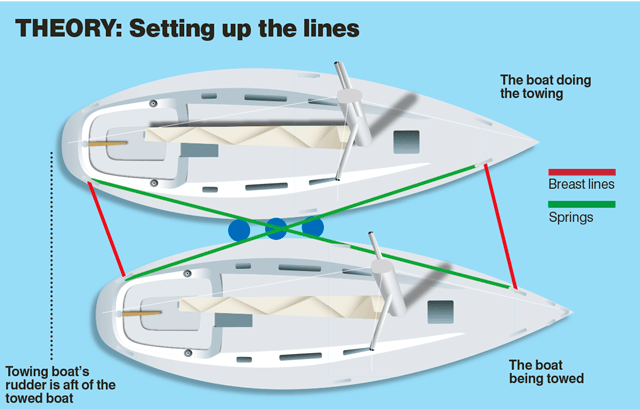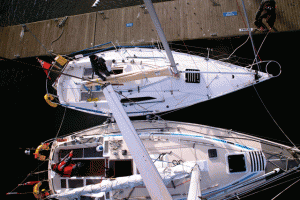Towing another boat in the confines of a harbour means that you'll need to set up a tow alongside. Here's how...
Towing astern, which we covered in another article, is all very well at sea, but once inside a congested harbour or river it becomes difficult to manoeuvre safely. Add tide into the mix and you’ve got a very tricky situation on your hands. You need a way to turn on a sixpence and be able to put the boat precisely where you want it.
That’s where an alongside tow comes in. After we’d made the mouth of the River Hamble with our astern tow, and as soon as we were back in flat water, we manoeuvred my Impala 28 Polly alongside our towing boat Hakuna Matata, a Westerly Fulmar kindly lent by the British Offshore Sailing School.

Use your strongest lines for the springs – they take nearly all the strain under tow. The breast lines help to keep the boats parallel, especially when turning
Alongside tow: yacht to yacht
We had considered lining up our alongside tow in the approach channel, but soon discounted this – a sharp chop meant that coming alongside would have been tricky. Instead, we waited until we were in a relatively wide part of the river itself, before casting off the astern tow line.
Coming alongside
Before we cast off the astern tow, we made sure that both boats had fenders rigged on the appropriate side, and both breast lines and springs were tied on and ready to deploy. In other words, both boats were ready for the alongside tow. With the tow cast off, Hakuna Matata motored around in a circle and came alongside Polly’s leeward side, where willing hands passed over the lines.
Under Tow
To start off, slowly increase engine revs, keeping the speed down until you’re sure all is well. You’ll find that as long as you’ve positioned the tow boat’s rudder aft of the other boat’s transom, it’s easy to manoeuvre – just remember that you’re now twice as wide as before!
It’s vital someone mans the helm on each boat, and coordinates the steering. We tried keeping the helm of the towed boat amidships, and it made steering much more difficult. By comparison, when both tillers were matched, the two boats turned on a sixpence.
You can turn more tightly with the towed boat on the inside, as it rotates within the tow boat’s turning circle.
Coming alongside under yacht tow
As effective as an alongside tow is, its ultimate aim is to put the towed boat alongside a pontoon or quay. How you do this depends to some extent on the nature of her berth. For instance, you may struggle to get into a tight marina berth, so it’s often best to negotiate with the local harbour master for a temporary berth on an easy-access pontoon. We tried it on a long, empty pontoon at first, but after a practice run gained the confidence to try a smaller gap.
First of all, we tried it with the tow boat in charge, as Hakuna Matata’s helmsman tried to put the towed boat alongside the pontoon. But we found a few problems with this. Most pressing was the fact that, rafted a boat’s width from the pontoon, the tow boat’s helmsman couldn’t see what was going on, with the result that we ended up some yards from our planned destination.
Next time, we tried it with the towed boat’s helmsman in control. This worked much better, and has notable advantages. The skipper of the towed boat will be used to coming alongside his own berth, and knows the prevailing conditions. Best of all, he’s in the prime position to see what is going on. With this arrangement we came alongside perfectly, with the tow boat simply being used as the motive power. Constant communication, matched tillers on both boats, and the towed boat’s helmsman in control made things much easier.

1: The helmsman of the towed boat has a much better view of the pontoon, so is in control as the raft-up approaches the berth.

2: The skippers synchronise their helms to approach at a shallow angle, with the tow boat acting as the motive power.

3: Both skippers apply starboard helm as the tow boat applies reverse gear. Don’t forget you’ll take longer to stop than usual.
Alongside tow: RIB to yacht
In really tight spaces, a RIB or launch is the ideal tow boat. In many cases, if you tow a yacht into harbour, the harbour master or boatyard will be able to come and take over the tow in his launch to put the boat alongside. We borrowed marine photographer Eddie Mays’ RIB to rig up an alongside tow by motorboat.
Setting up the tow
Which side you tow on depends upon the tow boat’s fittings – some RIBs only have strong points on one side. Either way, the RIB driver is likely to know his own boat’s capabilities. Even though a RIB is cushioned, it’s still worth setting up some fenders, mainly to stop black marks being rubbed on the side of your boat.
As with towing by yacht, to make steering and handling easier you want the tow boat’s rudder, or in this case a steerable engine, to end up astern of the towed boat’s transom. Ideally, the lines should be set up so that the two boats’ bows are slightly converging.

Towing with a small RIB – the principle is the same as when towing with another yacht, but the result is far more manoeuvrable. You may need to be careful when it comes to finding strong points to tow from.
Under tow
The engine on a RIB is likely to be designed for high speed, rather than slow running. Therefore, the driver should take care to increase revs slowly to avoid both prop cavitation and overloading the engine. Co-ordinate your steering with the RIB’s driver. As the RIB was shorter than the yacht that had we had previously towed with, the sheering force on the breast lines as we turned was more obvious – showing how important it is to use a dedicated strong point.
Coming alongside under RIB tow

With the RIB motor in tickover, the raft approaches the pontoon. The RIB is fairly light so the raft is able to manoeuvre relatively easily.

A quick burst of astern and we’re secured alongside. The steerable RIB engine can act like a thruster if required.

The RIB’s steering matches that of the yacht, as the yacht’s skipper comes alongside the pontoon with the RIB providing the power.
Marina berths
Especially in tight berths, the RIB may not be able to come into the berth with you. In this case, he may untie you and give you a ‘push’ into the berth, with just enough way on that you can glide in and come to a gentle halt. This depends on the skill of the driver, so have plenty of fenders and your warps ready for any occurrence.










